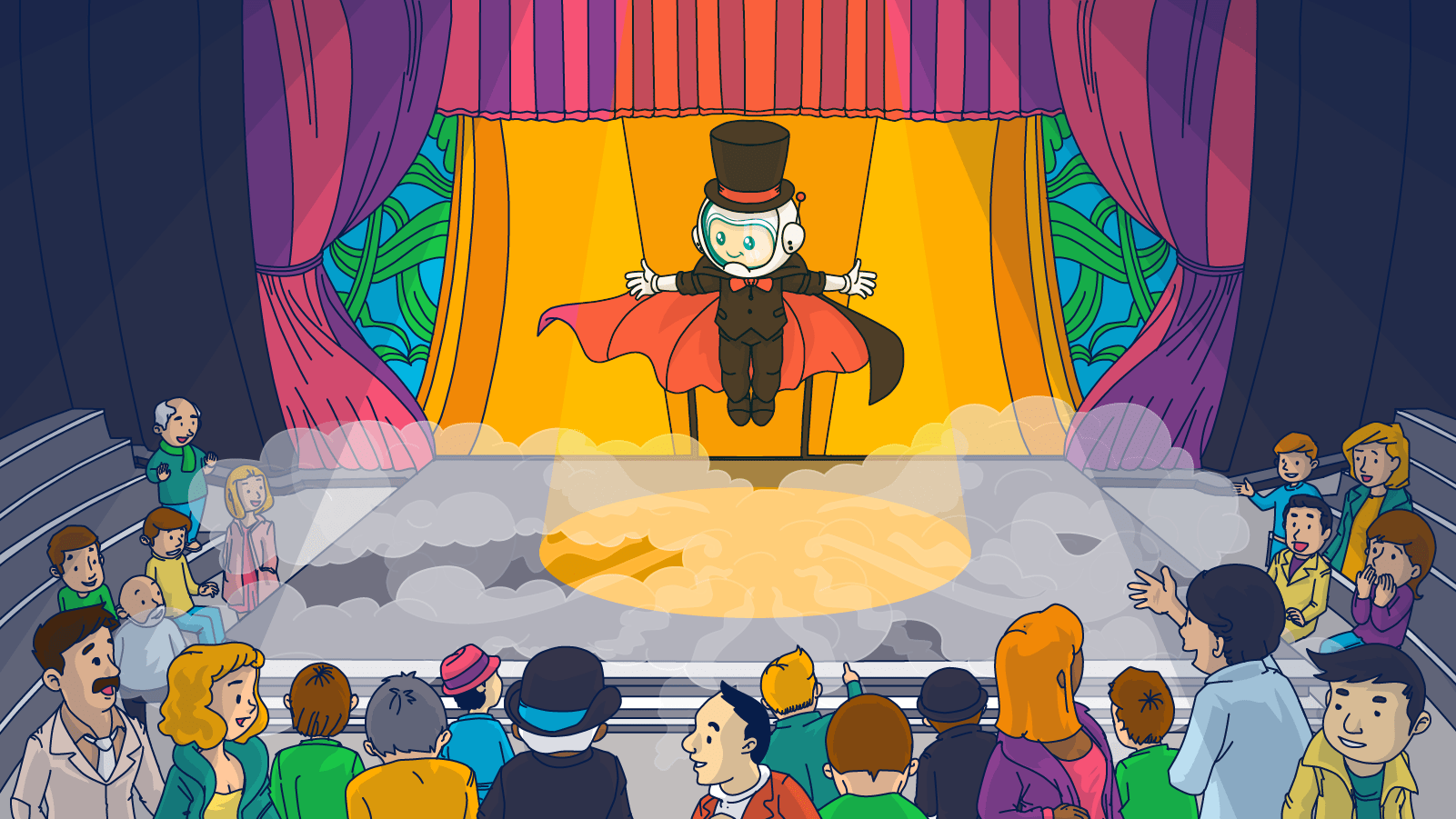Go through these re-engagement email examples, and join me as I dive deep into the analysis of relationships that have gone stale and inevitable ends that are avoidable. Oh, and I’ll also show you how to craft some win-back copy and design worthy of applause!
Success in no small part depends on gaining and maintaining your customers’ attention in email marketing campaigns. Sure, there’s no doubt that investing in customer acquisition is an engine you need to have in place. Still, when your customers can switch to `the competitor’ with a click or a tap of a button, you need to have in place some countermeasures that will keep the customers you’ve acquired too.
Happy, returning customers are powerful contributors to your business’s growth. Your best, most loyal customers tend to spend more and are more likely to recommend it to others.
If you have already lost some of your subscribers’ attention, fret not. While some churn is to be expected, re-engagement email campaigns can reduce your churn rates substantially.
If you don’t believe that you should re-engage email subscribers, know this. According to a Return Path study, 45% of those who received re-engagement emails continued to interact with the next email in that campaign.
Not having them in place may cost you a lot and is an opportunity to make good with customers who are slipping away. It takes little effort, and convincing them to stay means you’ll increase your average lifetime value (LTV) and other KPIs.
In this article, I’ll show you great re-engagement email examples and explain how to launch them effectively to reactivate and win the hearts of everyone that missed the value that you provide.
What is a re-engagement email?
Re-engagement emails are targeted messages sent to members of your subscriber list who have interacted or engaged with your emails in the past but have not done so lately. Sometimes called win-back or reactivation emails, re-engagement emails aim to recover the attention of an inactive or lapsed subscriber.
Often, businesses send a re-engagement email or series of win-back emails as a last ditch effort to reignite a subscriber’s interest before sunsetting or removing the contact from their active list. A timely re-engagement campaign can help email marketers identify those leads that still have potential by prompting an active response from the recipient.
Re-engagement emails should only be sent to subscribers whose behaviors meet the sender’s criteria for being unengaged or lapsed. As such, all re-engagement campaigns are initiated by behavioral triggers. In the case of re-engagement emails, of course, the behaviors are inactions rather than actions or the absence of engagement.
Individual brands define their own levels of non-interaction and which channels to measure when defining when to categorize a subscriber as lapsed or eligible for a re-engagement campaign.
Reactivation campaigns can be automated and scheduled as bulk or triggered sends. For example, the sender could define a re-engagement segment to include anyone who hasn’t opened or engaged with the brand’s emails in the past 30 days. Then on a designated date, send everyone in that segment a re-engagement email or the first in a re-engagement series. Subscriber who respond to any email in the campaign are removed from the segment because they aren’t lapsed anymore.
Creating behavior-based triggered campaigns enables more granular targeting. Instead of sending a bulk message to the selected segment, businesses using automated, triggered emails can choose to initiate a re-engagement campaign on the day that a specific contact meets the defined criteria such as 30 days since the last open, click-through or website visit.
I’ll explain more about how to decide your criteria for identifying lapsed subscribers and when to send them your win-back messages later in this article.
But first, why invest time in trying to recover subscribers that aren’t that into you? Lots of reasons. ⬇️
Why are re-engagement campaigns important to the success of your email marketing program?
Re-engagement emails help you realize the full value of your list building and lead generation efforts by maintaining your subscribers’ interests beyond the customer acquisition phase.
Houdini brought to light this previously misunderstood practice. David Copperfield took it to the next level and added brighter lights, music, and assistants. Penn and Teller? Why they incorporated offbeat, quirky humor! If you’ve ever seen a skilled magician perform, you were probably amazed at their ability to keep their audience engaged.
From the opening flourish to the final bows of the performance, a magician works to direct everyone’s gaze to just the right place at just the right time. This careful pacing and steady control of the audience’s attention are what make the magic happen.
Similarly, email marketers need to script their email campaigns carefully to ensure that the audience stays engaged. It isn’t enough to start off big, and hope the momentum will carry them through. You need to carefully monitor your subscribers’ attention and take steps to regain those who lose interest.
How much is a re-engagement email campaign worth?
There’s real value in customer retention, and it goes beyond the $$’s.
How much value? What type of value?
The truth is–it depends.
As eCommerce matures, customer loyalty is increasingly important for sales and growth.
It is easier to gain conversions from existing customers, and existing customers often have higher average order values (AOV) than new buyers.
Although many studies were published on the subject, you don’t need any research to tell you that it costs much less to keep an existing customer than to acquire a new one. Your excel sheets can tell you that.
Check your data and ask yourself:
- How do your customer acquisition costs (CAC) and retention costs compare?
- Are AOVs higher for repeat customers?
- What do your average customer lifetime values (LTV) graphs look like? Do your customers tend to spend more over time?
- What about the average LTV for your most engaged customers?
You’re probably getting some good numbers in the above metrics, but the benefits don’t end there:
- Accelerated sales cycles. Investing in re-engagement email campaigns allows you to skip the usual awareness and jump straight to the bottom of the funnel with customers who know your brand and have interacted with you in the past.
- Lowered customer acquisition costs. Maintaining customer engagement is a channel for increased sales and expanded reach. Oracle predicts that in 2022 loyal customers will be one of the brands’ biggest acquisition assets as they provide referrals and promote brands on social media.
- Improved list management. Re-engagement email campaigns also bring closure. Every email list experiences decay, and you should periodically prune inactive subscribers.
But, how do you know which email addresses to cut?
Your re-engagement campaign will give you the answers you need, enabling you to keep subscribers who show promise while ending your relationship with those who just aren’t that into you.
What can happen if you don’t regularly revive your subscriber list? A look at the dark side of lapsed subscribers is up next.
What can go wrong when you hold onto unengaged subscribers?
Ideally, a re-engagement email campaign will recapture your lapsed subscribers’ attention and increase your brand’s revenue. But, you have to decide whether a subscriber should stay or go at some point. Keeping `the unengaged’ on your list comes at too high a cost.
Here are just some of the ways it’s going to hurt you:
- It’s bad for your deliverability and your sender reputation. Running campaigns to ensure that you send messages to valid, active addresses is part of good email hygiene.
Sending messages to inactive or unused email addresses can cause bounce backs that hurt your sender reputation. For example, your messages will get a soft bounce if the email service provider has suspended the address due to inactivity or the mailbox is full. You’ll “earn” a hard bounce, or worse, if the address is gone for good.
Even messages that make it to the inbox can be a problem if your subscribers ignore them. Internet service providers judge your reputation based on how your subscribers respond (or don’t) to your emails. If your messages are consistently deleted before they are opened, that’s not a good look for you.
After a while, it may not be your subscriber’s fault that they don’t engage with your messages–too many non-interactions and your emails will start getting sorted to the spam folder.
There’s also the risk of receiving a deliverability death blow. You’ll be on a lot of naughty lists if your inactive subscriber’s email address has been recycled as a spam trap.
- It distorts your metrics. Data-driven email marketing requires clean data. When a large percentage of your email recipients aren’t active, it impacts your engagement and conversion metrics.
Particularly if you are analyzing performance metrics based on your entire subscription list to make targeting and segmentation decisions, you may make decisions based on rates that don’t reflect the needs and preferences of your “real” customers.
Does it really matter if 75% of your subscribers live in a cold climate if 90% of those same subscribers are unengaged? You might be promoting ski boots when you should be pushing sandals.
- It diverts resources. Email is an affordable way to reach a broad audience. But it isn’t free. If you are sending emails to subscribers who aren’t that into you, you are diverting resources that could be used to communicate with your true audience.
- It causes you to overlook other opportunities. Just because someone doesn’t engage with your brand via email doesn’t mean they don’t engage with your brand. When you aren’t responsive to the signals your customers are sending you (e.g., “I don’t want to receive emails from you”), you miss the opportunity to find other ways to stay in touch.
Instead of trying to connect with customers your way, find the channel that works for them.
Forrester’s 2021 Predictions noted that CMOs planned to increase their customer retention and loyalty spending by 30% in the coming year.
Let’s talk about the strategy that makes re-engagement email campaigns work.
How do I re-engage an email list?
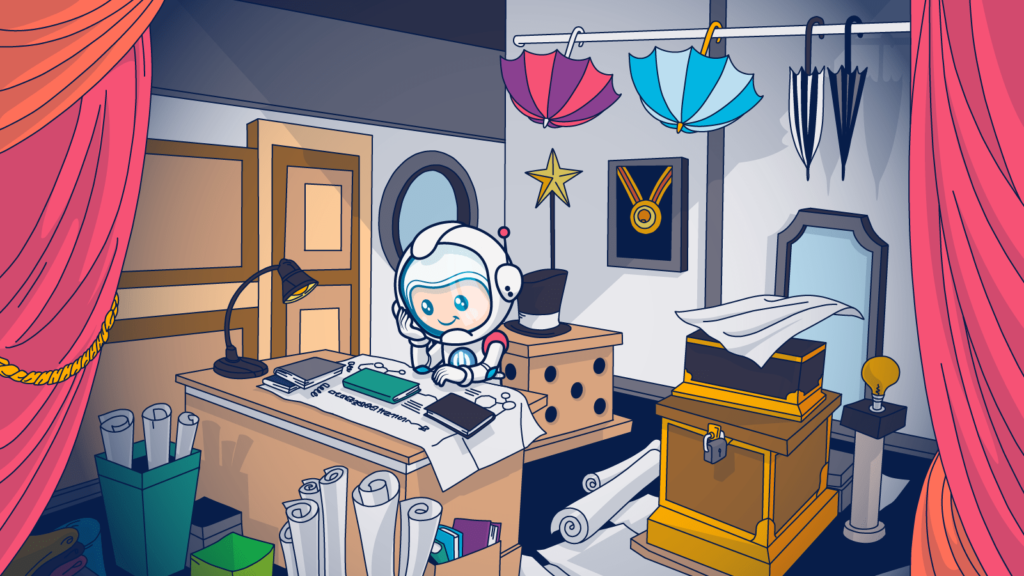
The most engaging magicians dedicate years to the craft. They study and practice their technical skills to perfection. But, technical prowess alone won’t do. The skilled magician must understand their audience and keep them captivated because, without an audience, there’s no show.
Your re-engagement strategy requires a similar dual approach. Your email marketing skills must be complemented by a data-driven understanding of your audience. Otherwise, your efforts may fall flat.
You can’t just send an “I see that you haven’t opened my emails for a while now, here’s a 150% discount” email and expect results. You start with data.
The first steps are to identify which subscribers should be candidates for re-engagement and which ones should not.
Validate your list
Ideally, every email address on your subscription list will be an active, valid address. But, we don’t live in an ideal world. So, before you begin investing time and resources (and risking your reputation) by launching a re-engagement campaign, do a little house cleaning.
Segment email addresses with no engagement signals for a specified period and use a service to run a batch validation test on these addresses. As Ayal points out in his article explaining how and why to run validation tests, revalidating your list can help you clear out addresses that were valid when you received them but aren’t anymore.
The purpose of this first pass-through is to eliminate inactive addresses and spam traps before you begin your re-engagement email campaign. If you are confident in your list-building and hygiene practices, you can probably run your list through validation every six months.
Decide how you’ll define inactive subscribers
After you eliminate non-existent and invalid emails from your subscriber list, you’re left with your engaged and lapsed subscribers.
To separate your engaged subscribers from those you need to reactivate, you’ll have to decide what engagement means for your brand and how long a subscriber should be inactive before they are a candidate for re-engagement.
What counts as engagement?
Nowadays, when we talk about engagement, we often focus on click-through rates. But your customers don’t live in a land where email is their only means of communication. They are multi-channel engagers. Your subscribers blithely skip from SMS to social media to email and back without a care for how this messes with your engagement metrics.
Gathering first-party data about your audience is critical. The more you know about where your customers are and how they interact with your brand, the more you’ll be able to reach them.
Evaluate the following metrics to gauge your subscribers’ level of engagement with your brand across various channels:
- Email engagement rates. Your email performance metrics are an obvious place to start. Which engagement rates to look at may not be as obvious. In the past, open rates would have been a go-to KPI to whether or not subscribers were interested in your emails.
As new privacy rules keep coming, the usefulness of open rates continues to decline. You may never know if your subscriber opened your message or not. In response to Apple’s rollout of Mail Privacy Protection and other privacy initiatives, I and other email experts advise looking for other signals in your data, such as the absence of click-throughs and conversions, to confirm that they aren’t paying attention to your messages anymore.
- Non-email engagements. Before sending your customer an email asking them where they’ve gone, check a few of their common hangouts. Are they interacting with your brand via SMS or on social media? If so, maybe you don’t need to keep them looped in on email too.
- On-site activity. You know the saying, “If it ain’t broke, don’t fix it”? If your subscriber is visiting your website, browsing, and making purchases, your relationship ain’t broken. They are connecting with you without engaging you via email.
Don’t mess up a good thing.
Instead of an email re-engagement campaign, think about how you can use email or other channels to support this thriving relationship. Employing relationship-building methods that recognize your subscribers’ preferences deepens their connection and loyalty to your brand.
How long is too long?
Like with the best magic tricks, timing is critical when executing your re-engagement campaign. Contacting a customer too soon to say you miss hearing from them can make your company seem careless or needy.
So when should you attempt to revitalize your email relationship with a subscriber? The answer depends on your email sending patterns and your customer buying cycles.
High-frequency senders should make sure they’re getting through
The fewer emails you send within a given period, say a month or a year, the fewer opportunities your subscribers have to interact with them. You may have longer inactive periods without it indicating an engagement problem.
If you are sending an email every day of the week and some subscribers aren’t engaging? Then, the window of inactivity becomes smaller, and you can start sending re-engagement emails sooner rather than later.
Subscribers are more likely to engage when they need something from your brand
In addition to the frequency of your contacts, consider your customer buying cycle when defining how often you expect subscribers to engage. How often does your average customer need to interact with your brand?
A cosmetics brand is likely to have much shorter buying cycles than a mattress brand.
Use order gap analysis (OGA) to pinpoint when most of your customers make repeat purchases by calculating the average time between orders.
A gentle nudge at just the right moment like the one Filterbuy sends customers who interacted with them in the past may maintain the momentum, enabling you to re-engage with a single email.
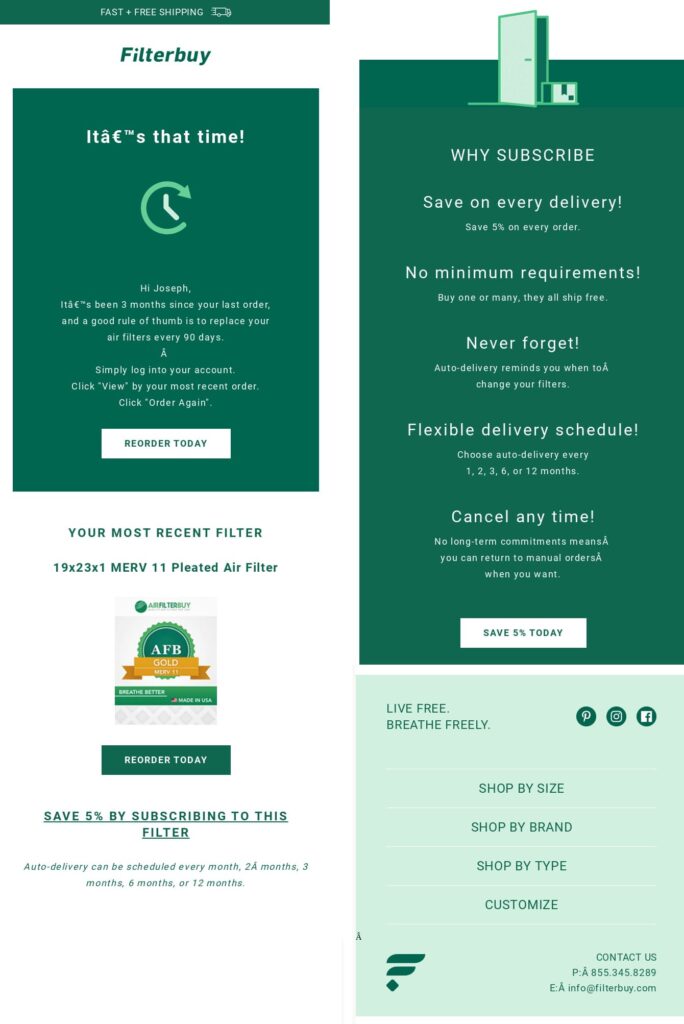
Filterbuy makes it easy for subscribers to continue their relationship with the brand by sending this message at just the right time and including all the information the customer needs to reorder easily.
Of course, averages don’t give you each customer’s exact behavior patterns, and different segments of your audience may have different buying cycles.
Make sure you use these numbers as a starting point. As you’ll start running regular re-engagement email campaigns, continue to collect data, fine-tune your strategy and develop more detailed segments.
Targeted re-engagement email campaigns are segmented
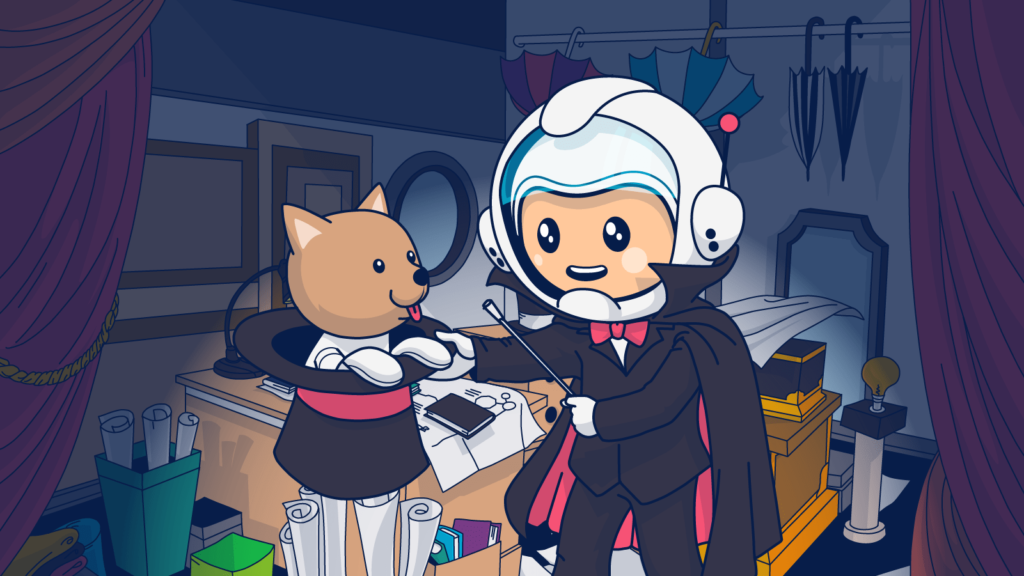
Segmenting your dormant subscribers into smaller groups allows you to focus your efforts where they are likely to have the greatest impact. A semi-engaged subscriber is a better candidate for revival than one who has totally disconnected from your brand years ago. Better yet, tailoring your re-engagement emails based on data from these subscribers will increase your chances of winning them back.
Use segmentation analytics to identify and distinguish between the many types of less engaged subscribers. It will also allow you to connect better with subscribers who may doubt your commitment to them.
The events of 2021 have caused consumers to care more about how brands make them feel, and according to another Forrester research, they attach loyalty to the brands that make them feel “appreciated, happy, and valued.”
Who would have thunk?
Generic one-for-all messages won’t make your subscribers feel special, but a targeted message to a well-defined segment can.
Plus, once your segments are identified, you can employ event-triggered, automated campaigns to reach your flagging subscribers with perfectly-timed, personalized messages, and to do so at scale.
Here’s what I mean.
Say you have one group of `gift-giving’ customers who only shop with your brand around the holidays and another who purchase items for themselves every month. Your approach won’t seem very personal if you try to re-engage annual and monthly shoppers with the same message.
It might make sense to wait a bit longer before declaring your year-end gift-givers lapsed. On the other hand, you don’t want to let too many months pass by before you reach out to your steady customers.
In addition to looking at buying cycles, look at your subscribers’ other behavior and demographic data to develop focused segments.
For example, some of your lapsed subscribers may show a strong preference for shopping only if they receive a discount or free shipping. If you want to wow this group with your win-back email, you’ll need to bring an offer they can’t refuse.
Noom offers a free trial plus up to 90% off in this “please come back” email entreaty.
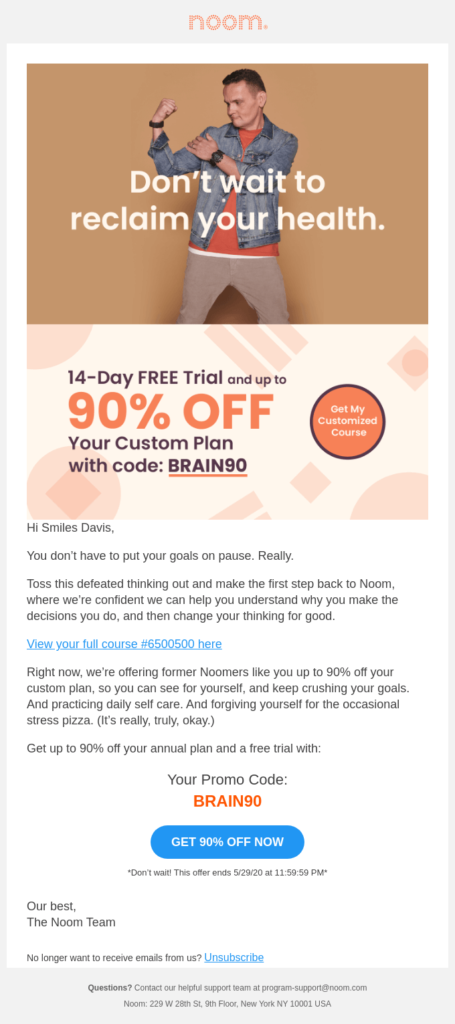
When developing your segments, think outside the box. Look for uncommon reasons in your data to understand why some of your subscribers might have lost interest that might band them together.
Have you discontinued a favorite product or experienced a series of customer service complaints related to a specific item or service?
If you’ve seen a drop in engagement after a product or shipping problem, ask forgiveness and sweeten it by offering some much-needed value that will revive your customers’ trust.
Doesn’t have to be a discount btw. Value comes in many forms. But yes, discounts work as well 🙂
This email from Avocode acknowledges that the site may have had performance issues in the past and offers the recipient a 20% discount to give the design collaboration tool another chance.
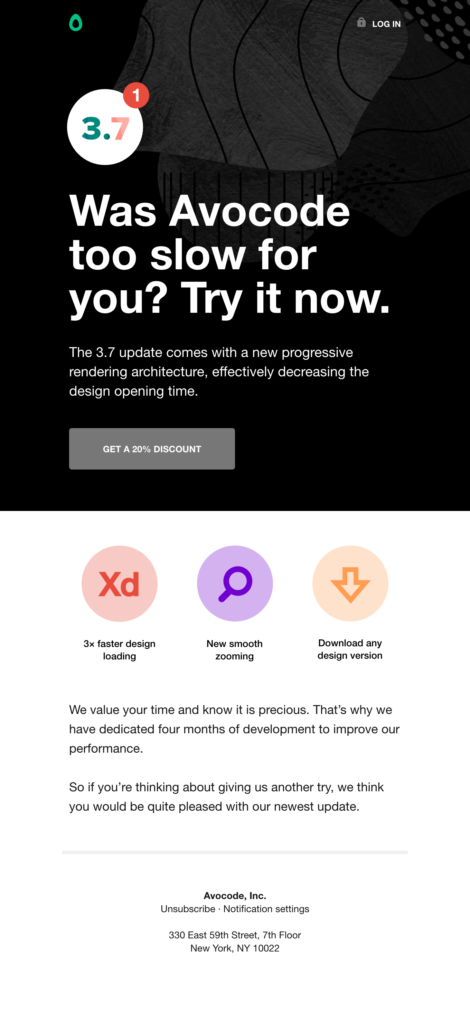
Try goal-focused segmentation
You can use the information about your customers to create segments based on your re-engagement email strategy goals: increasing revenue and improving your list quality.
Evaluate your lapsed subscribers and segment them based on your likelihood of achieving one of these objectives by messaging them. Then, customize your message for each segment (and objective).
Here are a few ideas to get you started:
- Go for the easy wins. Customers who purchased from you in the past and have been out of touch may just need a little reminder to win them back.
Create a re-engagement segment that includes subscribers who have made at least one purchase and are the most recently lapsed in order to send them a quick email to revive their interest.
Back Market turns on the charm in this sunny email to draw subscribers back to its website.
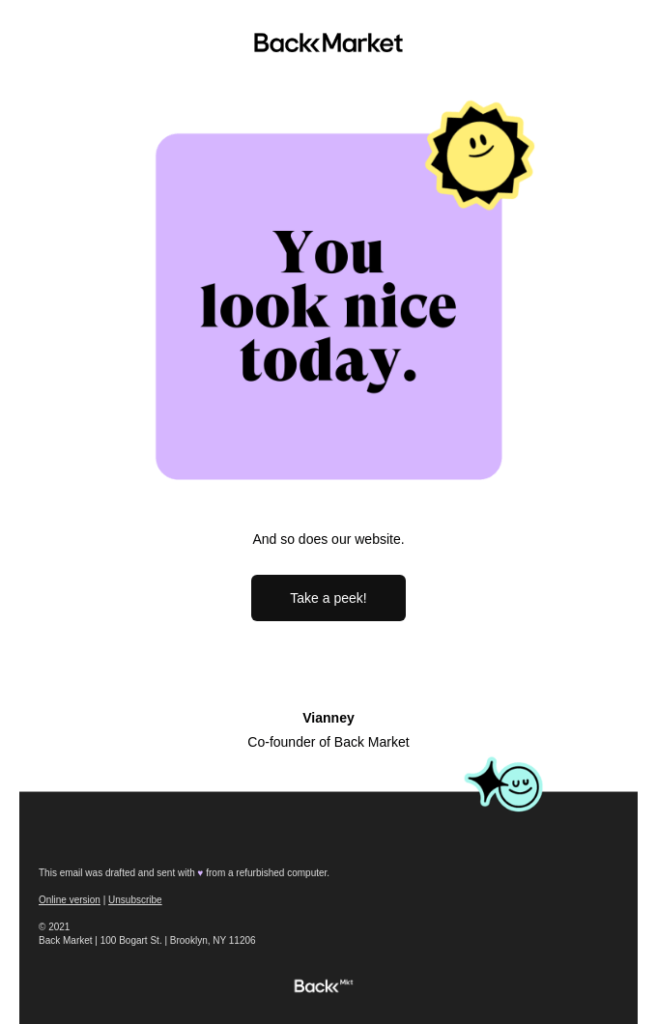
- Look for the big catches. It takes just as long to create an email campaign for your $30 AOV customers as your $300 ones. So, why not aim high?
Create a win-back campaign targeting lapsed subscribers with a high LTV or average order value and give them the VIP treatment.
Winning just 1% to 2% of these customers back can make a big difference at the end of the month.
- Loyal to the end. Losing touch with a customer who was a member of your loyalty program is particularly painful. Don’t let it happen if you can help it.
Like your big spenders, you’ll want to give these subscribers special attention when trying to win them back. Their past behavior points to a desire to belong and share, so send them a message that incorporates social proof or extra rewards for their continued loyalty.
- Clear the decks quickly. You probably have some subscribers on your lapsed list that never made a purchase or engaged with your emails. Your messages may have never made it out of their spam folders. Is it worth investing a lot of time trying to reach them now?
For email addresses that show no signs of life, send one or two “Is this goodbye?” messages like the one below from Chief Marketer before removing them from your list.
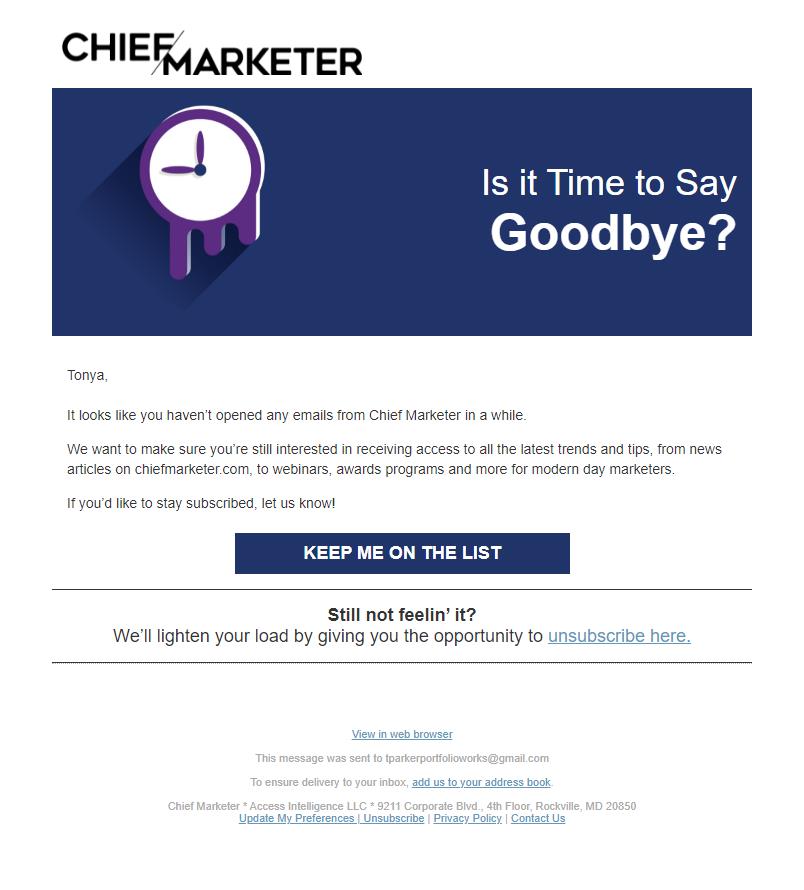
- Still interested but not interested in email. When you identified your larger lapsed segment, you likely had some email subscribers who were still engaged with your brand–just not your emails.
A message that says, “We miss you,” will make it look like you aren’t paying attention. So instead, acknowledge that emails might not be right for them and ask if they’d like to adjust their communication preferences.
Have these tips engaged your creative side? Check out Melissa’s article about email personalization for more segmentation + personalization ideas.
Later in this article, I’ll share more content strategies and a list of my favorite re-engagement email examples. But for my next trick, I’ll break down some of the other decisions you’ll need to make to perfect your re-engagement emails so they won’t fizzle away when it’s showtime.
Choose each campaign’s technical features
“Nothing must be left to chance in a magical performance. Everything conducive to enhancing the mystery must be arranged with painstaking care and thought.” —David Devant
Every element of your win-back campaign, from the segments you select to the copy you create, contributes to its success. That includes the more technical aspects such as how and when you’ll send your messages.
You shouldn’t send the same message to every segment, nor at the same time. Consult your data as you make the following decisions about your campaign:
Do you need a separate IP or subdomain to send your re-engagement emails?
Launching a campaign with the express intent of targeting your least engaged subscribers can be a risky business. You should expect engagement rates to be low, a factor that can influence your sender reputation.
For that reason, some experts recommend that you use a separate IP or even create a subdomain from which to send your re-engagement emails.
Neither of these methods will fully shield your reputation but they can reduce the harm caused by this type of campaign’s traditionally low-engagement rates. Read more about domain reputation in this guide. As always, we wrote everything you’ll need to know there.
Whether these precautions are necessary depends on the scope of your campaign and the strength of your reputation.
You’ve been sending emails to these unengaged subscribers for quite a while (or they wouldn’t be in a win-back segment). If your sender reputation is strong and you’ve practiced good sending and list hygiene, the total risk of sending one last series of emails to these subscribers is relatively low.
On the other hand, if you were already experiencing some deliverability turbulence, you may want to use a separate IP or subdomain to send your re-engagement emails. Consult with your ESP before launching a wide-scale re-engagement campaign–especially if you are using a shared IP.
How many emails should you include in your re-engagement sequence?
When a magician puts on a show, they usually select a series of tricks and transitions, bringing them together to enchant their audiences with a complete story.
The emails in your win-back campaign should tell a cohesive story, too. This is your last chance to hold onto your audience. Give your campaign a better chance of success by sending a series of emails that share a common storyline but offer different appeals.
Unless, of course, you just want to get things over with fast. Chief Marketer’s message in the email sequence below is conciliative but clear: act now, or it’s over.

Telling your story through a multi-message automated drip campaign requires planning. Just don’t go too far. The time you invest should be proportionate to your anticipated ROI. In other words, save your most complex sequences for your most promising segments.
Also, don’t forget to include events and triggers that stop your sequences so that once a lapsed subscriber responds, they don’t receive any more win-back messages. 😳
You can make this happen automatically by using Ongage’s automation rules and dynamic segmentation.
A collection of email types that might appear in your win-back sequence
- The light memory nudge: “Hey, how’s it going?”
This low-pressure approach may appeal to subscribers who don’t want to feel sold to.
- The direct approach: “We miss/haven’t seen you.”
This message acknowledges a growing distance between you and your subscriber.
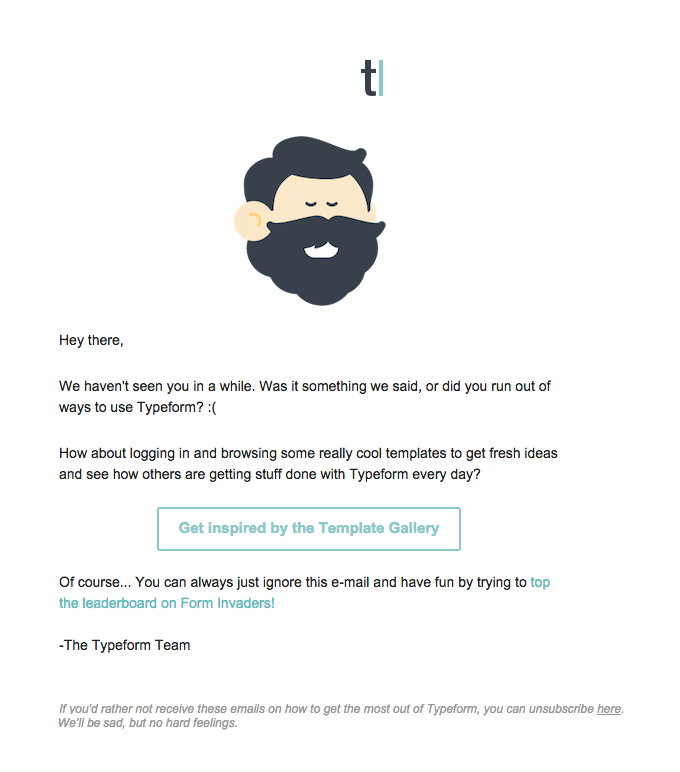
- Flattery is everything: “We really appreciate you.”
A well-timed thank you for your business can revive a failing customer relationship.
- Here’s what you’re missing: “We rolled out some great new features recently.”
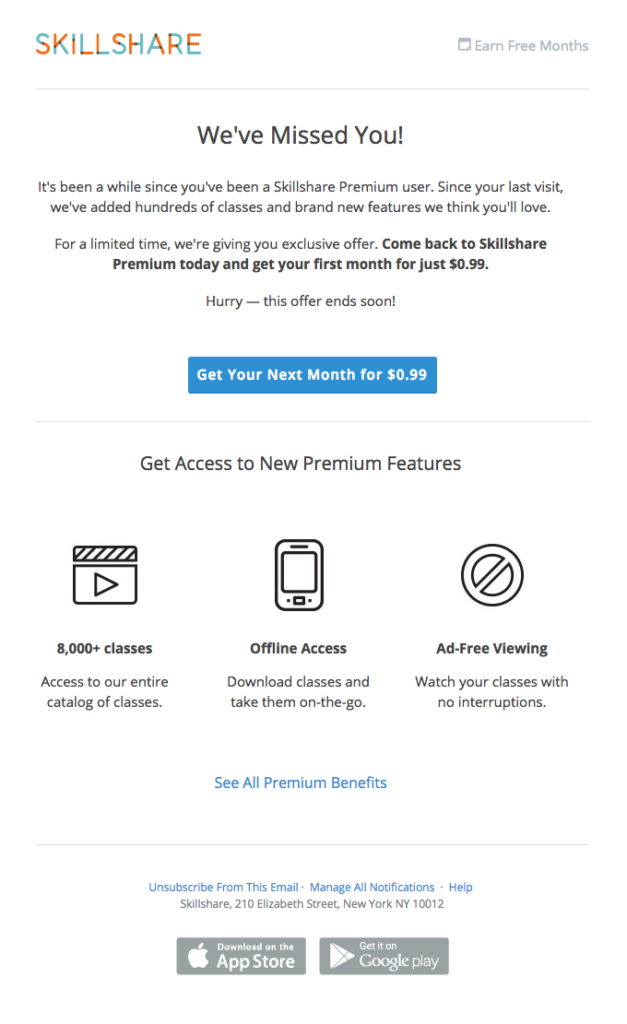
Curiosity is a powerful force. The promise of something new may inspire your subscriber to visit your site to check it out.
- Has something changed? “Update your account so we can serve you better.”
This approach demonstrates concern for your customer’s needs and brings them back to your site.
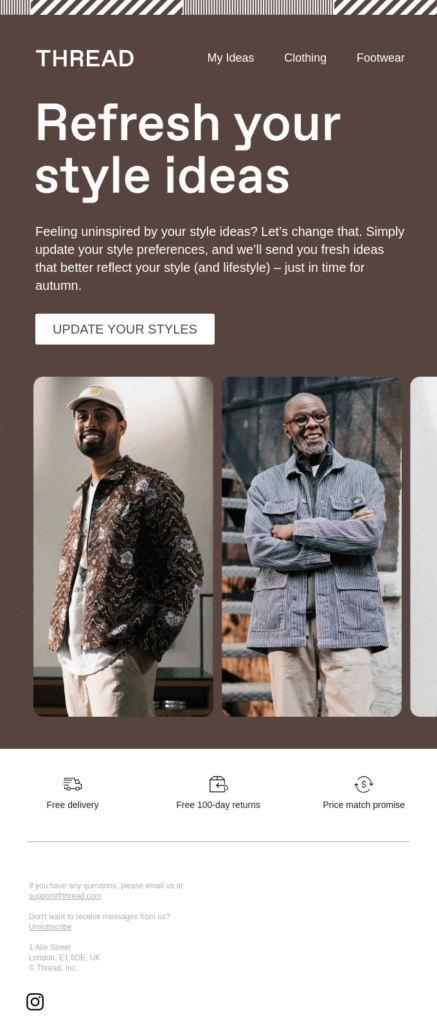
- FYI: “This new how-to guide is just what you need.”
Buying guides, product reviews and other content that educates are low-pressure, value-adding ways to reconnect with your customers.
- The belonging appeal: “Everyone misses you/your participation.”
These messages remind your user of the community they are missing when they disengage from your brand.
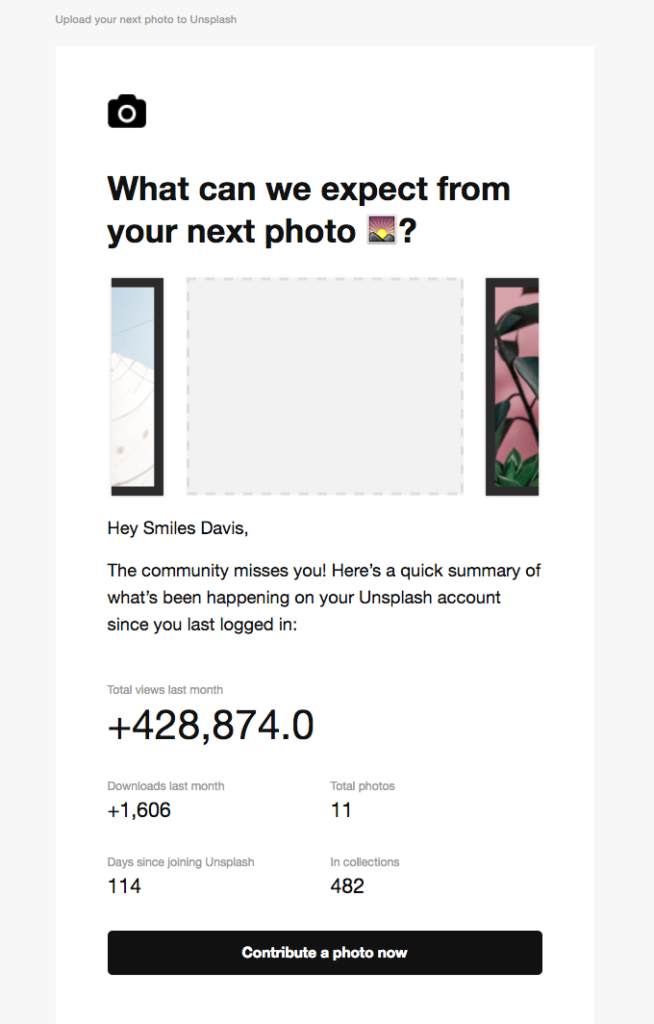
- The offer: “Come back now and get 50% off.”
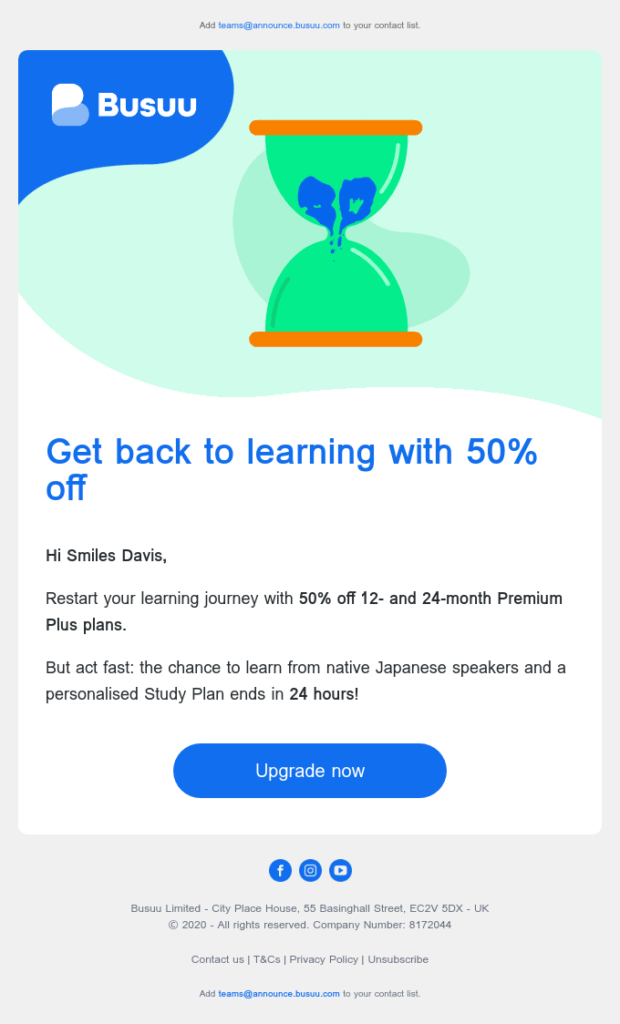
- The question, “What’s in it for me?” Answered.
- Share your thoughts: “We’d love to have your feedback.” Sometimes people just want to feel heard.
- Coming attractions: “We’re launching a new product line soon. Stay tuned for the announcement.”
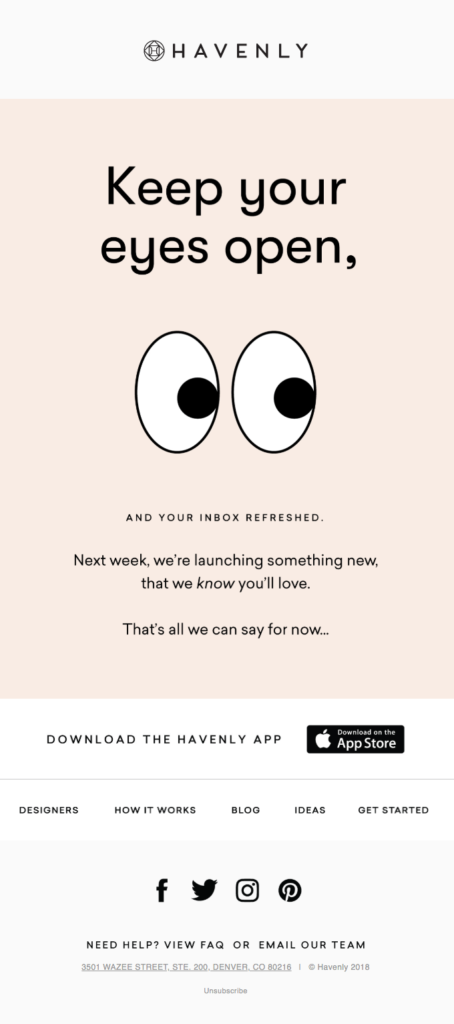
A coming soon message stimulates both curiosity and a little touch of FOMO with your email recipients.
- Social proof: “You should stick around. Here’s what people are saying about us.”
Maybe your subscriber isn’t quite sure if they should like your brand. A little social proof can give them the affirmation they need.
- What if we communicated less?: “Would you like to change your communication preferences?”
Before you say “Goodbye,” it’s worth offering alternatives. This message also puts the subscriber in control. Empowerment feels good.
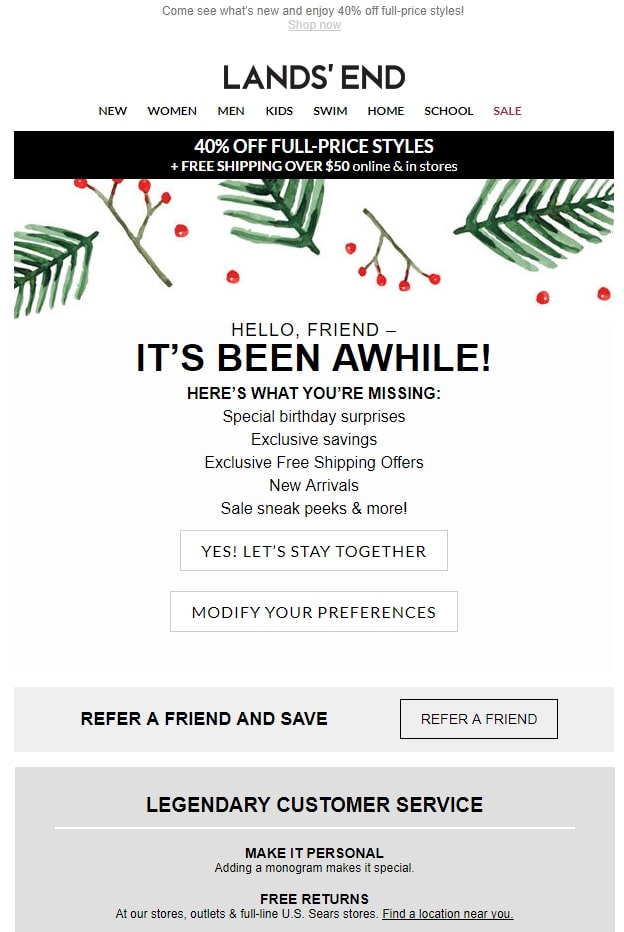
- It’s the final countdown: “If we don’t hear from you by this date, we’ll take you off our list.” This one is more of a courtesy. It’s okay to need closure.
How far apart should you space the messages in your re-engagement drip sequence?
After deciding how many and what types of emails to include in your sequence, it’s time to choose your cadence. The rate at which you send your win-back emails should mirror your usual practices. So, if you regularly send recipients 3 to 5 emails a week, that should be the cadence for your re-engagement campaign.
If you only communicate once a month, you can speed things up a little during this last pitch. However, suddenly sending daily emails is likely to seem odd to your recipients and ISPs.
Also, consider your target segment’s behavior. When they were engaging with your emails, how often did they open your messages? If your messages sat in their inbox for a week before being noticed, you may want to put a similar space between each of your re-engagement appeals.
Examine your past, and also check out our best time to send research. It will help you select send times that suit your audience.
When is it really over? Sunsetting subscribers that don’t respond to your re-engagement emails
Maybe all good things don’t have to come to an end, but some of your email relationships will. The final decision for your re-engagement campaign will be when to call it over.
This is a strategic decision that will help you to set the rules and the tone of your campaign.
You have to decide how long after you send the final email in your campaign series will you wait before removing a subscriber from your active list? Just so you won’t need to deal with it again.
After you set your `waiting period’, use automation to remove these email addresses once your deadline has passed.
And trust me on this, your heart will go on.
Enchant subscribers with these re-engagement copy and design tips

A well-planned re-engagement email sequence will only succeed if your content gets your message across. They need to open your email and respond to your email if their engagement with your brand is to be revived.
To develop your content, start by choosing the appeals that you’ll incorporate into your campaign. Here are some examples:
- A humorous approach that asks where they’ve gone – we should see more of those.
- An emotional appeal that expresses how much you value the subscriber’s business or miss them – it’s hard to make them work, but if done properly, they’re great.
- A value-focused campaign that details what’s in it for the subscriber and why your brand is right for them – a personal favorite.
- A helpful campaign that asks what you could do better or what you can offer to get them to come back – a classic.
Once you defined the broad strokes of your theme, you can go into more detail and decide when to use each of your appeals. For example, if you want to use emotional triggers, which ones will you use?
FOMO, belonging, trust, and loyalty are all powerful draws. Interested in more copywriting tips to polish your re-engagement messaging? Check out this astounding guide we put together for you, How to Become an Email Copywriting Master.
YNAB expresses empathy in its email encouraging lapsed subscribers to stick with the program.
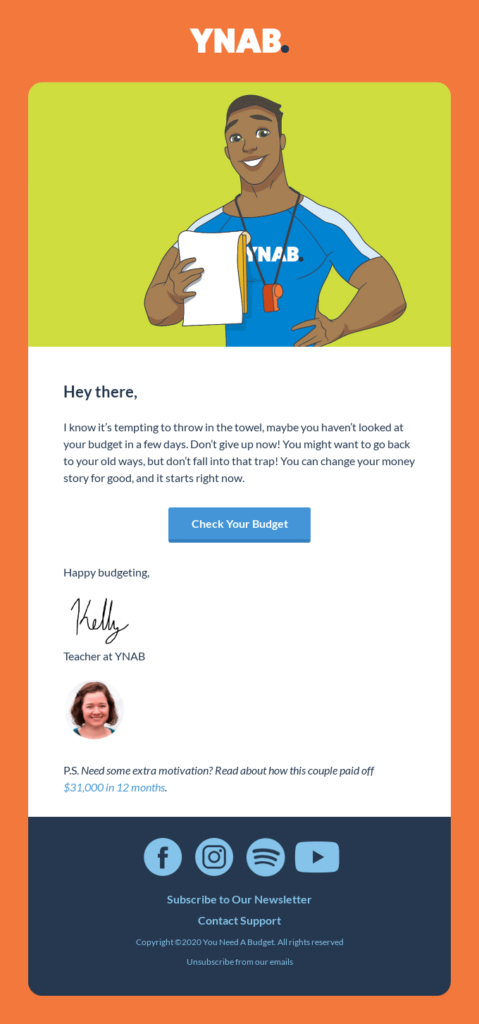
In contrast, Google hinges its message on our human needs to be needed in this comeback message.
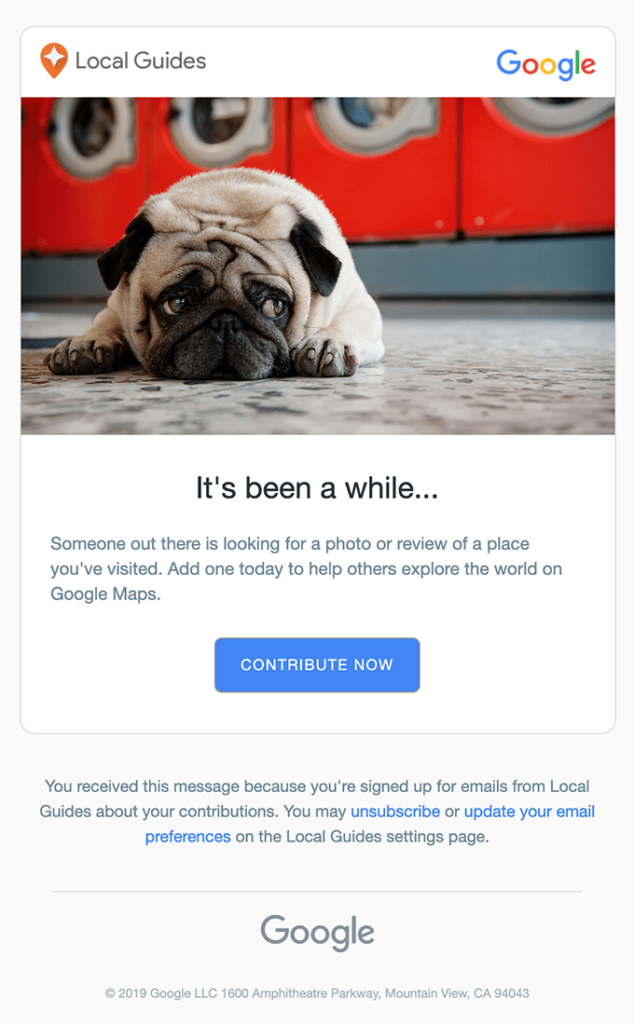
I remember a time in which Google’s slogan was “do no evil”. I feel kinda bad, and I’m not even the email recipient. Just saying.
Recover email subscribers’ attention by addressing their reasons for leaving
One reason people might be turning away from your emails is a lack of accessibility. Ayal explains how designing for accessibility can improve your email’s engagement rates in his article, Improving Email Deliverability Through Engagement.
After following the advice there, test your email’s content using a screen reader to ensure that your message comes through loud and clear for every user, including those with visual impairments.
Another reason subscribers lose interest is that the content doesn’t add value to them. Are you paying attention to which email messages resonate with your subscribers or just sending out the content you think will work? Follow your reports closely to understand which types of emails have led to your top successes in the past and look to those emails to guide your re-engagement email copy.
Should you offer discounts in your re-engagement emails to win back customers?
Money isn’t always the reason someone is unengaged with your brand, and it won’t always be the solution to bring them back. But, sometimes, as mentioned, it’s the money. 🙂
Discounts can encourage a wavering subscriber to take action. Before you offer a deal, though, consider your other options and your ROI. Can you offer a non-monetary incentive such as extra loyalty points, VIP status, or other incentives to accomplish your objective?
Does the potential lifetime value of the lapsed subscribers justify the costs of the proposed discount.
Let your objective and CTA guide the content in your re-engagement emails
Next, develop your campaign goals. For re-engagement emails, this part is pretty simple. Your conversion goals will be related to restoring engagement.
Do you want the subscriber to visit your website? Click a button to stay subscribed? Adjust their communication preferences or provide feedback?
Once you’ve selected your goal, write your call to action (CTAs). These CTAs will define where each email is headed, something you need to know before creating the rest of the content that takes readers there.
Think beyond “Shop Now” for your CTA. Remember, your CTA is your last chance to win that subscriber back!
In the email below, GoPro skips the usual “shop now” CTA and emphasizes savings with a FOMOish “Grab This Deal” instead.
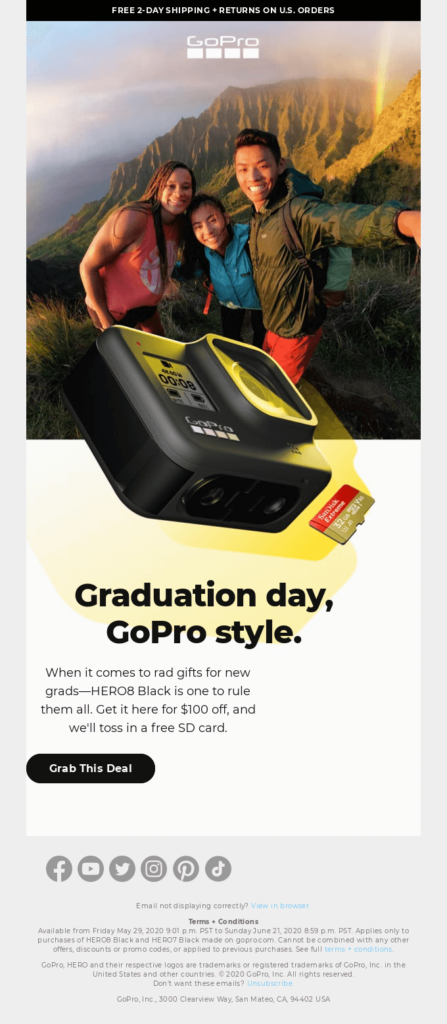
16 examples of enchanting re-engagement CTAs to reactivate lapsed subscribers
- “Keep me on the list”
- “Keep sending me deals”
- “I want to stay in the loop”
- “Let’s stay together”
- “I miss you too”
- “Adjust my account settings”
- “Let me see the new stuff”
- “Visit our site”
- “Update my preferences”
- “Keep me opted-in”
- “Yes, I’m in!”
- “I don’t want to say goodbye”
- “Get my discount”
- “Claim my rewards”
- “Yes, I want 10% off”
- “I’m still with you”
Don’t forget the power of images in your emails, either. Please your subscribers’ eyes and minds with attractive graphics and product images that let them see just what they are missing.
Astley Clarke offers subscribers several reasons to visit the jeweler’s website, and the product close-ups are stunning.
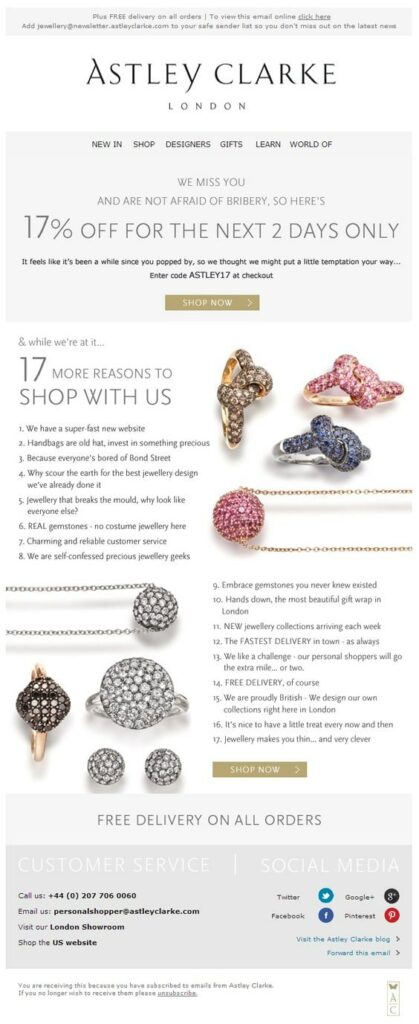
Use extra captivating subject lines to make lapsed subscribers want to open your re-engagement message
Finally, create subject lines that match your CTA to send a cohesive message from start to finish.
Your subject lines should aspire to intrigue your audience and give them a reason to click. Choose the language that inspires emotion or curiosity or tells subscribers what they’ll get if they click. We wrote a whole guide about email subject lines that you can refer to.
Alder puts it all together and seeks to keep the momentum going with a new subscriber. The email’s subject line reads: “Your 10% off code is waiting for you.” Then, the email incorporates action-focused product images and fun, on-brand CTAs like “let’s have some fun” that make you want to click.
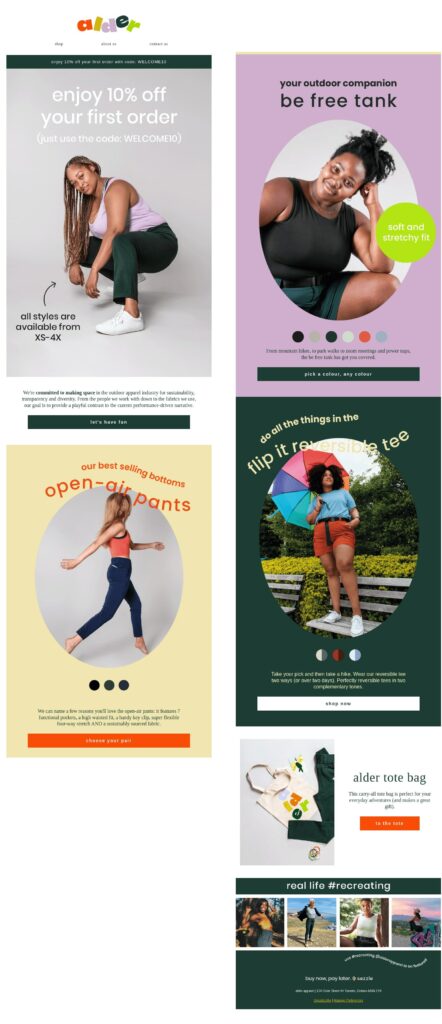
This email just talks to you, and the vibe is extremely happy.
And Rather’s email just cracked me up!
The brand takes a humorous approach to stimulate subscribers’ interests with this email’s subject line, “Heads or tails.” The email asks subscribers to click to vote, adding an interactive element that is guaranteed to spur engagement.
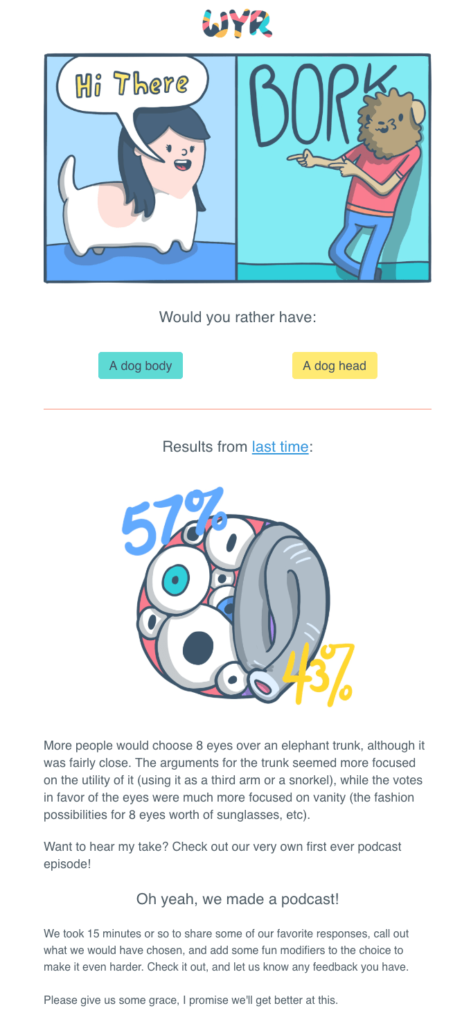
Use dynamic content and automation to personalize re-engagement emails at scale
Automation allows you to go beyond creating customized segments for your re-engagement campaigns. You can also develop custom-configured journeys for each subscriber. Combine your subscriber data with email templates that incorporate dynamic fields or blocks for truly one-of-a-kind messages.
Using dynamic content, you’ll be able to automate a tailored response that will be based on data types like when the subscriber was last in contact with your brand or what types of products they purchased in the past.
In addition, you can craft customized messages that make personal recommendations based on each subscriber’s preferences.
In this re-engagement email example from Yelp, a reviewer gets a personalized email based on their recent visits.
.
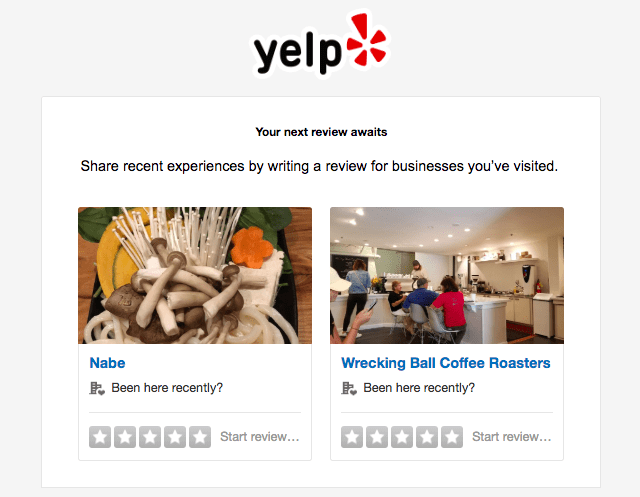
When using personalization, be sure to respect your subscribers’ privacy by only using information they shared with you. Don’t go all, “I know what you did last summer,” and surprise them with information they aren’t aware that you have.
Take your message multi-channel
Previously I mentioned that some of your subscribers may have moved on from email and that’s why your messages aren’t hitting the mark. How can you reach these subscribers with a re-engagement campaign?
Should you give up on reaching them just because they don’t do email? No way!
Create a multi-channel campaign that reinforces your re-engagement email campaign and continues its theme. Use retargeting and organic social media posts to encourage your customers to interact with your brand, update their communication preferences in your CRM, and use it as a segment.
Then, work on meeting them in conversations that started via email, and link to social, or any other platform. The same can be done btw with SMS, just check out this guide on combining SMS marketing and email.
How might such a scenario look?
- Your retail brand is launching a new product line and wants to use this fact to revive its customer base.
- You start with a homepage highlighting the line and an exciting new product page.
- Then, you bring traffic organically and via paid means, announcing the line.
- Organic social posts talk about the line and feature customers’ feedback.
- One of the social posts includes a “secret” discount code.
- Next, you send a “Coming soon” SMS to your customers, telling them to watch their emails for a surprise.
- Customers then receive an email with an exclusive sneak peek at the new line and a different discount code for those who “buy now.”
For lapsed subscribers, the SMS copy and email subject line mention that the brand doesn’t want them to miss out on this exciting new line of products.
When it’s time to deliver your message, your audience will be more likely to remember it.
Test your re-engagement emails, adjust and continually improve
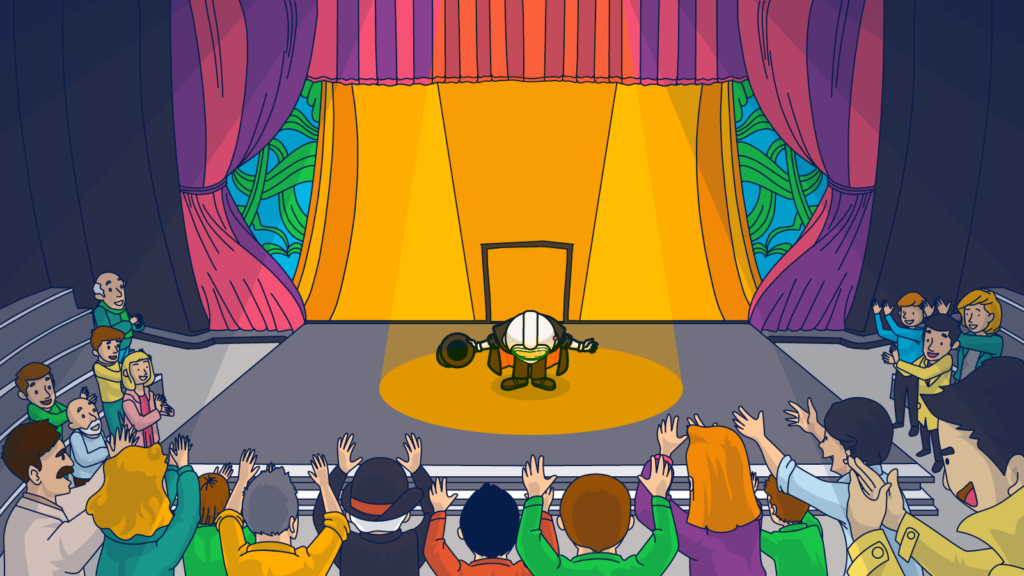
What’s better than guessing and hoping for the best? Making data-driven decisions.
One-size-fits-all doesn’t work. Your subscribers are unique. Their response to your re-engagement campaigns will be too. So, use past data to guide your initial strategy, but don’t stop there. Continue to collect data and test your email campaigns to find out what works best for each of your segments.
Use split campaigns (a.k.a. A/B/n testing) to create competing campaigns and let your audience tell you what works best. Evaluate your content to understand:
- When and how often you send your messages?
- How many messages do you ultimately send?
- When evaluating the success of different variables, be clear about what success means.
- Do you want to keep your number of subscribers high or narrow your list to just those that deliver the highest ROI?
As an FYI, Ongage’s Automatic A/B split testing enables you to automatically distribute the winning test variant to your subscription list or segment once the test has been completed.
This article was all about keeping the subscribers you’ve gained. If you’d like to learn how to get more qualified subscribers from the get-go, check out this guide about sign-up forms for our best list-building advice.
Until next time, don’t fear the reaper!

